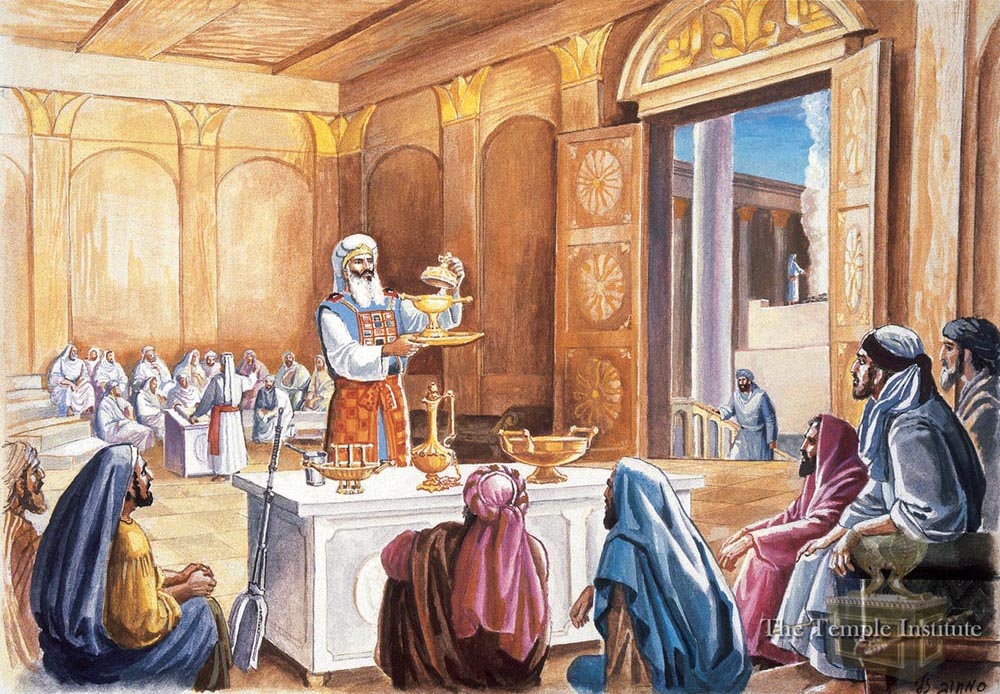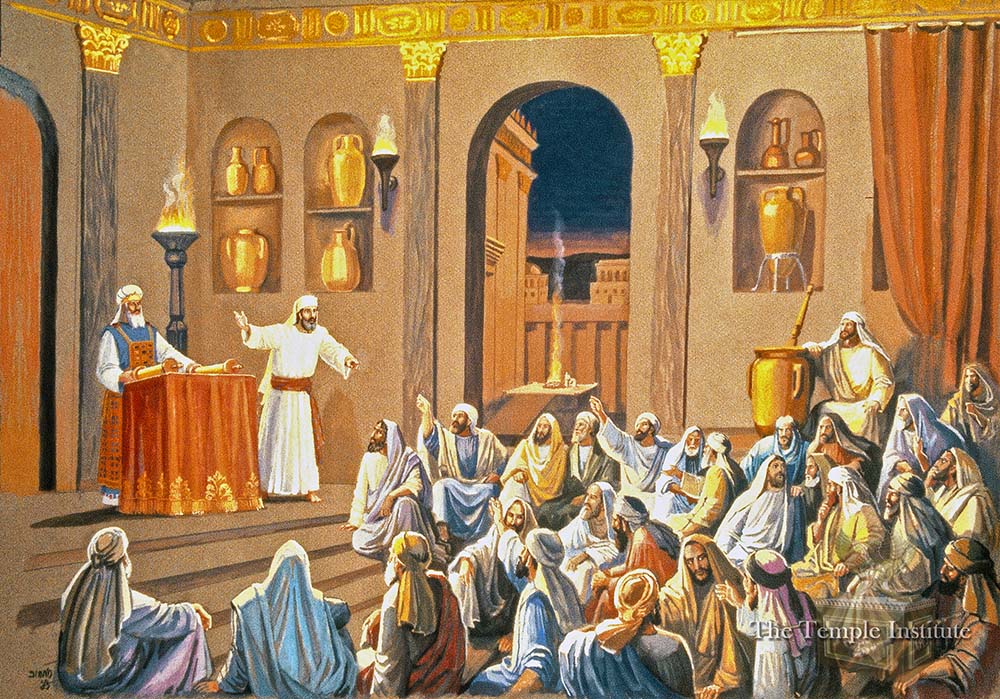
https://templeinstitute.org/yom-kippur/
*한국서버에서 접속 불가로 이 페이지에 공유해 드리니 개인적으로만 참고 바랍니다.
All the holy activities that took place in the Holy Temple all year round were but a lead-in to the ultimate climax: the Yom Kippur service.
The service of this holy day was the only one in the Beit Hamikdash (Holy Temple) that was fully and sequentially carried out by one specific individual: the Kohen Gadol (High Priest).
On this day, and only on this day, the Kohen Gadol wore both his golden garments and his white garments, and performed the entire Yom Kippur service, on behalf of the entire nation. The service was intensely detailed and had to be performed with precision.
The Gemara (Berakhot 7a) vividly describes the climactic and solemn Yom Kippur entry of the Kohen Gadol into the Holy of Holies – the one time each year that anyone may do so. Reading the account, one gets the sense that the Kohen Gadol is actually entering the Sanctuary on High, and is standing before the very Divine Throne of Glory. The Gemara states, in the name of the High Priest and great Torah giant, Rabbi Yishmael ben Elisha: “I once entered the Holy of Holies to bring the incense, and I saw there Akatriel Ya, the Lord of Hosts, seated upon a high and exalted throne, and He said to me, ‘Yishmael, My son, bless Me!’ I replied, ‘May it be Your will that Your mercy overcomes Your anger and Your mercy may prevail over Your attributes, so that You may deal with Your children according to the attribute of mercy and stop short of the limit of strict justice!’ And He nodded to me.”
Another dramatic description of the entry into the Holy of Holies is provided in Tractate Yoma (39b): “During the year in which Shimon the Righteous died, he predicted his death. They asked how he knew, and he said: ‘On every Day of Atonement, an old man, dressed in white and wrapped in white, would join me as I entered and left [the Holy of Holies]. But today, I was joined by an old man who was dressed in black and wrapped in black; he entered with me, but did not leave with me.’ After Sukkot, he was sick for seven days, and then he died.” It appears that the man who accompanied the High Priest was none other than the Patriarch Avraham (Bava Kamma 50a). Escorting and helping the Kohen Gadol in his mission to arouse Divine compassion and atonement for Israel was a special mission assigned to none other than the Father of the Nation, Avraham.
As he performs the uniquely sacred Yom Kippur service, the Kohen Gadol is simply an emissary for the entire nation. The Talmud (Yoma 18b) states: “The elders of the Beit Din [who accompanied the High Priest on Yom Kippur] gave him over to the Elders of the Priests, who brought him to the Chamber of Beit Avtinas, and told him: ‘Sir, Kohen Gadol, we are agents of the Beit Din and you are our agent and the agent of the Court. We adjure you by He that had His name dwell in this house not to change anything of what we have told you.’” Perhaps this is why the image/soul of the Patriarch Avraham escorts the Kohen Gadol into the Holy of Holies – to support him that he not fail in this tremendous mission that has been placed upon him on this very holy day.
Although the precise actions of the Kohen Gadol in the Holy of Holies are performed far from any human eye, they are not at all secret. Not only the other priests, but all of Israel who gather in the Azara (courtyard) at dawn of Yom Kippur follow every move the Kohen Gadol makes. In addition, the passages describing his actions are studied in detail in all Yeshivot, and have been recited aloud by generations of Jews throughout our centuries of Exile. Even little children learn the Seder HaAvoda, the order of the Yom Kippur service, and know its details, just as did the Kohen Gadol.
Throughout the service, the Kohen Gadol would purify himself and immerse in a ritual bath no fewer than five times, and would wash his hands and feet ten times from a golden basin. He would walk back and forth in the Azara and Sanctuary forty-two times in order to fulfill all the mitzvot of the day, which were performed in various locations: The mikveh, the Azara, atop the altar, in the Sanctuary, and in the Holy of Holies – up until the point that he would “safely leave the Holy.”

The High Priest Bears Full Responsibility for the Service
As opposed to other ceremonies throughout the year, all of the sacred tasks performed on Yom Kippur, the Day of Atonement - tasks which bring about atonement for Israel - must be done exclusively by the High Priest (Kohen Gadol) himself. As the Torah states a number of times in the book of Leviticus, chapter 16: "and he shall make atonement for himself and for his household;" "until he comes out, and have made atonement for himself, and for his household, and for all the congregation of Israel," etc. He alone is responsible for every aspect of the Divine service on this most holy and awesome day: a total of fifteen separate offerings which are made, as well as the menorah, incense, and other services.

Throughout that week, the Kohen Gadol diligently studies the laws relating to the tasks which he must undertake on the upcoming sacred day, and he also conducts certain aspects of the daily service himself (even though it is not his exclusive duty) in order to familiarize himself with these actions. For example, during these days he himself tosses the blood of the daily sacrifice onto the altar in the morning and evenings; he offers up the incense on the golden incense altar; he attends to the service of the menorah (cleaning the used oil and wicks, adjusting new wicks and adding the proper measure of oil to each flame).
This is a period of intense preparation and review. Each day, the elders of the Sanhedrin (the supreme rabbinical court) read aloud before him from the biblical portion that relates to the service (Lev. 16).
